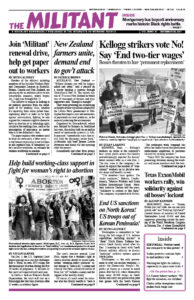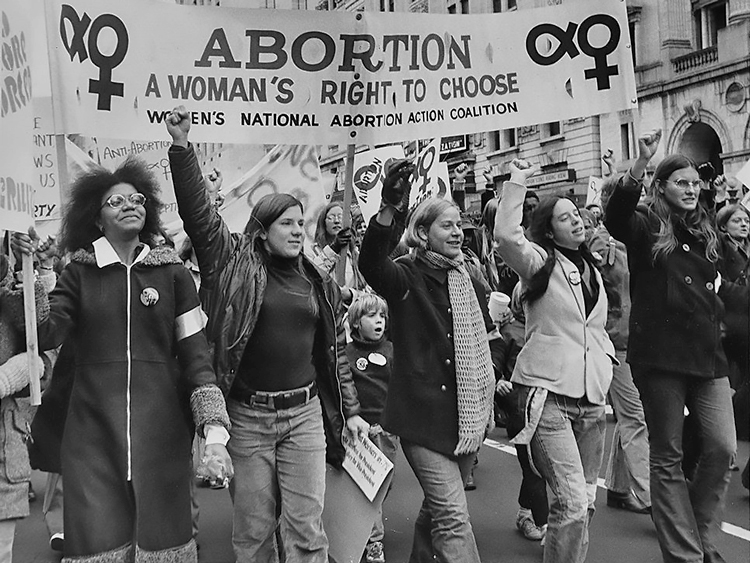On Dec. 1, the U.S. Supreme Court began hearings on a case that challenges Roe v. Wade, its own 1973 ruling that decriminalized abortion during the first 24 weeks of pregnancy. A decision by the court isn’t expected until next year.
In Dobbs v. Jackson Women’s Health Organization, the court will rule on a Mississippi law that bans abortions after 15 weeks, an arbitrary figure.
The state’s attorney general, Lynn Fitch, argues that a woman’s right to choose abortion should be tossed aside, saying “sweeping policy advances” allow women to “have it all,” a career and a family. For Fitch, a divorced mother of three, her “all” includes a nanny and the support of her wealthy family.
Of course, it’s much easier for someone who has family wealth to “have it all,” and anyone who chooses to have a family should be able to do so. But women must also have the unalienable right to determine whether or when to have a child, and abortion needs to be a legal option.
Who should decide — other than the woman involved — what to do when faced with an unwanted or unexpected pregnancy? Certainly not the government. Workers need to discuss and debate this issue all the way through, to win an overwhelming majority for the right involved, something that was cut short when the 1973 ruling was handed down.
The backlash against Roe v. Wade has been at the center of assaults on the social and economic gains of women ever since. It’s part of the broader attack on the rights and living conditions of working people.
These attacks on women’s rights were made easier by the character and content of the Roe v. Wade decision. It wasn’t based on the 14th Amendment, adopted after the Civil War overturned slavery, that says no state can “deny to any person within its jurisdiction the equal protection of the laws.”
In 1971 the Supreme Court affirmed that women were included in the amendment’s “equal protection.” That ruling was a product of victories won in the streets in the 1950s and ’60s by millions of fighters for Black rights, which spurred a new wave of activity in the fight for women’s emancipation.
But the Roe v. Wade ruling did not take that 14th Amendment as its starting point. Instead, it issued what one former U.S. solicitor general called “a set of hospital rules and regulations” on abortion, tied to fetal viability. And it assigned the decision not to the woman herself, but to her doctor. By forcing that ruling through before the raging debate that was taking place on this question was decisively settled, the justices ensured it would be followed by a relentless assault on women’s right to choose abortion.
New York Times columnist Ross Douthat hit the nail on the head in a discussion with other op-ed writers the paper printed Dec. 2. He said “successful” rulings by the Supreme Court “seem — as with same-sex marriage, so far — to follow dramatic and unlikely-to-reverse shifts in public opinion rather than trying to end arguments that are extremely live and ongoing.”
The character of Roe v. Wade gave an opening for immediate and continual attack, no matter whether Democrats or Republicans were in the White House. Within three years of the Roe v. Wade ruling, Congress passed the Hyde amendment in 1976 barring Medicaid funds for abortions.
State governments have loaded on more than 1,300 restrictions, continually cutting back on women’s ability to exercise their constitutional rights. These anti-abortion measures have taken a heavy toll. By 2017 there was not a single medical facility providing abortions in nearly 90 percent of U.S. counties.
The women who pay the highest price for this are those who can’t afford to travel greater and greater distances to find a location to get the procedure. Women in the upper classes can find willing doctors or fly to where the medical procedure is legal.
Before abortion was decriminalized, for most women who sought to end their pregnancies their only choice was an illegal, often life-threatening attempt to end a pregnancy. In the 1960s, thousands were maimed and hundreds died as a result of botched abortions. In 1969 in New York 210,000 women were admitted to hospitals for complications of illegal abortions.
Since this onslaught by opponents of women’s rights began in 1973, liberal-led women’s organizations have refused to organize a fight, arguing that women should instead elect Democrats to take care of everything, keeping workers within the trap of lesser-evil politics.
In the Times op-ed writers’ discussion, Michelle Goldberg says the best possible result of the court upholding the Mississippi law will be to rekindle “the anti-Trump resistance” she hopes will reverse Democrats’ declining electoral fortunes.
For women, the right to choose whether or when to have a child is theirs alone, a precondition for deciding what to do with their lives.
Women can’t rely on the flawed Roe v. Wade decision to defend their rights. Instead, working people and our unions should lead and win millions to back the need for women’s right to family planning services, including birth control and safe and secure abortion. It’s a right that’s fundamental to winning full social, economic and political equality, to unite and strengthen the working class.
Working people need the discussion that was cut short by the passage of Roe v. Wade. We can’t leave this question in the hands of the bosses, their parties, or their court. We need to launch a nationwide battle to lead a thoroughgoing discussion about the rights of women and the political stakes involved for our class — and carry that discussion through to the end.
Where fights like this are being organized worldwide — like in Argentina, Ireland and elsewhere — millions are being won over and gains are being made.
Such a fight here, including public meetings and demonstrations, can win a substantial majority to recognize abortion as a right all workers have an interest in defending. Our unions need to speak out on this question, just as today they take up fights against discrimination against women on the job. And this is the road to forging the unity our class needs to take on the bigger battles that lie ahead.


